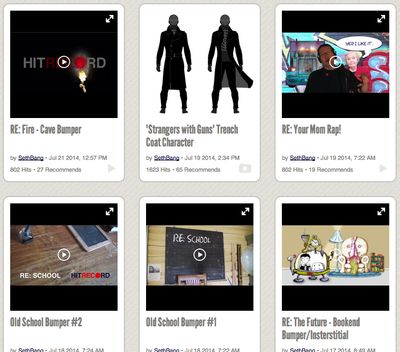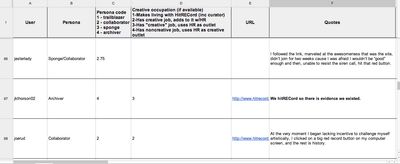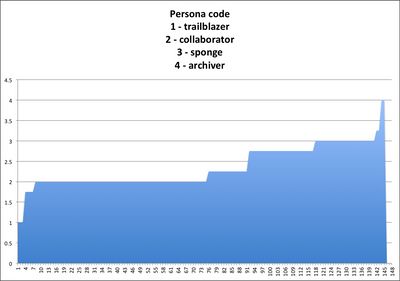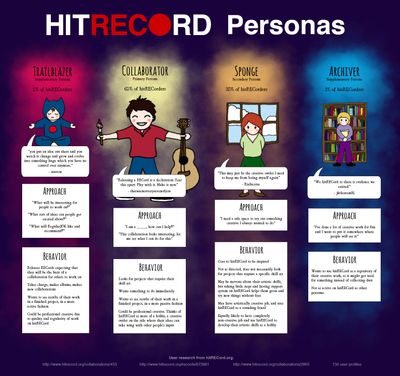How I did user research on hitRECord, from user-generated content

Let’s be honest here. “User research” seems like this giant mysterious thing that you can only have if your company has a dedicated UX department with trained UX researchers, and the financial resources to pay users generously for their time in talking with you. If you don’t have that, might as well throw up your hands and call it a lost cause, right? Wrong! There are always ways to find out (at least approximately) who your users are and what they think. It might not be perfect, but seriously, any user research is better than working with nothing. All you need to know, really, is motivation, intent, and context.
I came across such a quandary myself, in my quest to learn more about hitRECord’s active user base. Turns out you don’t have much to offer a stranger when you’re a random person who only has coffee or lunch to offer (and only if they were local to Los Angeles to boot!). But if there’s one thing I pride myself on, it is the ability to Figure Things Out. So I managed to find a way to get the main personas, by using the site itself.
hitRECorders, in their own words (motivation)
For starters, hitRECord.org is an open collaboration production company, combining the efforts of 300,000 artists around the world to make short films, books, music, and more recently, TV shows.
Because it is open and as anonymous as you make it, hitRECorders often share very personal stories on the site, in the form of text, image, video, or music uploads. These are referred to as “RECords.” There were several collections of work (known as “collaborations”) on the site that would allow me to get a better idea of why they participated in the community. It’s only natural that people would want to learn more about each other in a community like that. I went through all the text RECords from three specific collaborations that dealt with these motivations. I gathered quotes about why the artists joined the site and what the hitRECord community meant to them.
The collaborations I used were:
When I was done, I had quotes from 150 hitRECorders, organized in a nice spreadsheet.
What hitRECorders were actually doing on the site (intent)
To determine the user’s intentions on the site, I examined the recent upload history of all 150 hitRECorders in my spreadsheet, noting patterns and assigning values to the general types of work I saw.
- “Trailblazer” – mostly spearheads collaborations, expects others to work on them
- “Collaborator” – mostly works on active projects, fulfilling specific requests
- “Sponge” – mostly contributes to ongoing collaborations, but doesn’t aim for active projects or requests
- “Archiver” – mostly uploads own work without paying attention to other collaborations

What was interesting was that I had a hypothesis of what these personas would be: trailblazer, collaborator, archiver. Gathering the quotes and looking at the uploads actually made me add another – the “sponge,” because it didn’t fit in anything else. It’s very interesting what the data will show you if you let it!
What hitRECorders did off the site (context)
The last part of learning their motivations on the site, was to learn their context. Not all 150 hitRECorders had social media links in their profile, but I found and Googled as many as I could. The aim was learn what their “day job” was in order to determine how hitRECord fit into their life. Again, I assigned what turned out to be 4 values across the board:
- Considers hitRECord to be their primary daily activity (including special users known as “curators”)
- Has artistically creative job, adds to it with hitRECord work
- Has production job in a creative industry, uses hitRECord as artistic outlet
- Has completely non-creative job, uses hitRECord as artistic outlet
Personas
After assigning these two values, and noting that there was a general match between the two qualities, I came up with 4 personas:
- “Trailblazer” – mostly spearheads artistic direction, expects others to work on them. Primarily staff members, some curators. hitRECord is their primary daily activity.
- “Collaborator” – mostly works on active projects, fulfilling specific requests. Likely has production job in a creative industry or has serious artistic hobby, uses hitRECord as artistic outlet.
- “Sponge” – mostly contributes to ongoing collaborations, but doesn’t aim for active projects or requests. Often has completely non-creative job, uses hitRECord as artistic outlet
- “Archiver” – mostly uploads own work without paying attention to other collaborations.

I then analyzed the data to produce percentages of each user “type,” to see which was the predominating persona using the site.

…which resulted in the findings that I illustrated below.

So is this enough user research?
Pfft, no, of course it isn’t. I will be the first person to tell you that. What it is is a starting point. It is better than nothing. For example, I can tell you this data has the following limitations right off the bat:
- Some hitRECorders may be extremely active, but have not bothered to post anything in those 3 collaborations I was sampling from. I don’t have many of the “curators” (arguably the most active and dedicated non-staff users on the site) at all in my spreadsheet because of this reason. But if I didn’t know their motivations of joining the site to start with, I determined that I wasn’t going to go through with the rest of it. If I were to interview users, I would actually start with the curators, and I didn’t have that chance when gathering whatever quotes I could find.
- I didn’t talk to anyone directly when I came up with these personas. (I’ve since started to participate more on the site, which allows me to ideate along with and test with real users.) Sure, listening to what people say instead of observing what they do is still limiting, but at least you get the chance to get deeper into their motivations, intent, and context by simply asking them about it.
- I have no clue how each user actually uses the site. This would be the most fascinating thing for me to observe.
But I’d also argue that this approach also has several strengths:
- It is fairly cheap, aside from your own labor. You don’t need to pay users, you don’t need to spend 30-60 minutes per user talking to them. I gathered quotes from 150 users in the span of about 6 hours. A while, to be sure, but no way could you get that kind of sample in the same amount of time by talking to each user individually.
- You’re guaranteed a variety of users with that sample size. If you only talk to 12 people, you can come up with some rich personas, but how do you know they’re the right mix? With 150, you have more of an idea, even if the sample might still be skewed. Still better than 12, though.
But what if my site/app isn’t a social community where people write about themselves?
Do what you can! Look at tweets, look at Facebook, look at Yelp. Find where people are talking about your product and stalk them a little. (It’s not creepy if it’s public and for user research, really…)
And honestly, if they are talking about your product and complaining about it, the problem needs to be fixed right away! People only bother to post if it’s a really good experience or a really bad one, so those are the big issues you need to tackle ASAP. So even if you don’t have motivations or intent or context, at least you have that.
Your users are out there, and they are most likely online. Sometimes (usually?) the situation isn’t perfect and you just gotta do the best you can with the resources you have. Learning something about your users is always better than knowing nothing. 🙂
